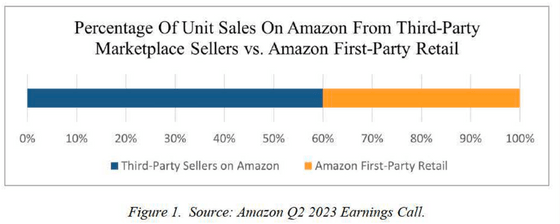What is the mechanism by which Amazon users provide users collected through benefits such as ``products, not customers'' and free shipping to marketing companies?

Many Amazon users think of Amazon as a site for Internet shopping. However, the authors argue that consumer retail is not Amazon's main source of revenue, and that third-party companies doing business through Amazon are Amazon's real customers, and users are just bait for them. Matt Stoller points out.
The FTC Sues to Break Up Amazon Over an Economy-Wide 'Hidden Tax'
Amazon offers over 100 million Prime members a variety of services and benefits, including 'free shipping,' and charges an annual membership fee of $139 (approximately 20,600 yen, compared to 5,900 yen in Japan). doing.

However, this membership fee is far from covering the cost of free shipping and unlimited content, and a JPMorgan analyst said, ``If you add up the value of each service, the true value of an Amazon Prime membership is $1,000 per year (approximately 148,000
That burden will ultimately go to users shopping on Amazon. Mike Beckham, co-founder of Simple Modern, a container manufacturer that sells products on Amazon, says, ``If you want to provide something that costs a lot of money, you have to recover that cost elsewhere.'' As a result, Amazon has become dependent on advertising. This is why search results on Amazon are getting worse and worse day by day. Show ads for your products above organic search results. That incentive is strong. I've been selling on Amazon for years, and I can tell you with confidence that advertising costs are factored into the price to the customer. , this is a hidden tax on customers.'
To clarify this point:
— Mike Beckham (@mikebeckhamsm) August 16, 2023
Prime could have been incentivized in other ways. For example, prime members get a % discount on every order. Free shipping wasn't required to accomplish the goal of growing customers.
When you give away something that costs a lot of money, you must find…
In a September 2023 lawsuit in which the US Federal Trade Commission (FTC) pursued Amazon for violating antitrust laws, one of the points of contention is the ``hidden tax'' that Amazon collects through its market monopoly. According to the FTC, Amazon has raised the barrier to entry for online shopping through its Prime service, and has used this monopoly power to give third-party companies access to inventory management services called Fulfillment by Amazon (FBA) and advertising on Amazon. It is said that they are partially forcing them to do so.
If a business doesn't follow Amazon, their products will effectively be excluded from search results. Regarding this, the FTC pointed out that ``Products advertised on Amazon are 46 times more likely to be clicked than non-advertised products.''
In this way, the fees that Amazon charges third-party companies have ballooned to account for 50% of Amazon's revenue, and the total amount is estimated to be $123 billion (approximately 18.26 trillion yen). supports services such as Amazon Prime's free delivery and Prime Video. And the burden that third-party companies pay Amazon will ultimately be passed on to the price of the product. This is the true nature of Amazon's 'hidden tax'.
The following shows the ratio of sales of third-party companies selling on Amazon's marketplace (blue) and Amazon's first-party sales, that is, Amazon's own sales (orange). It has been shown that more than half of all purchases and sales on Amazon are made by third-party companies.

From this point of view, Matt Stoller says, ``Most people think of Amazon as a retailer that sells things to customers.However, retail end users, ordinary consumers like us, It's not really the customer, it's the product. Essentially, Amazon is an intermediary that provides access to us, and the actual customer is a third-party company that relies on Amazon's infrastructure to sell their products. ” he said.
Related Posts:
in Web Service, Posted by log1l_ks







